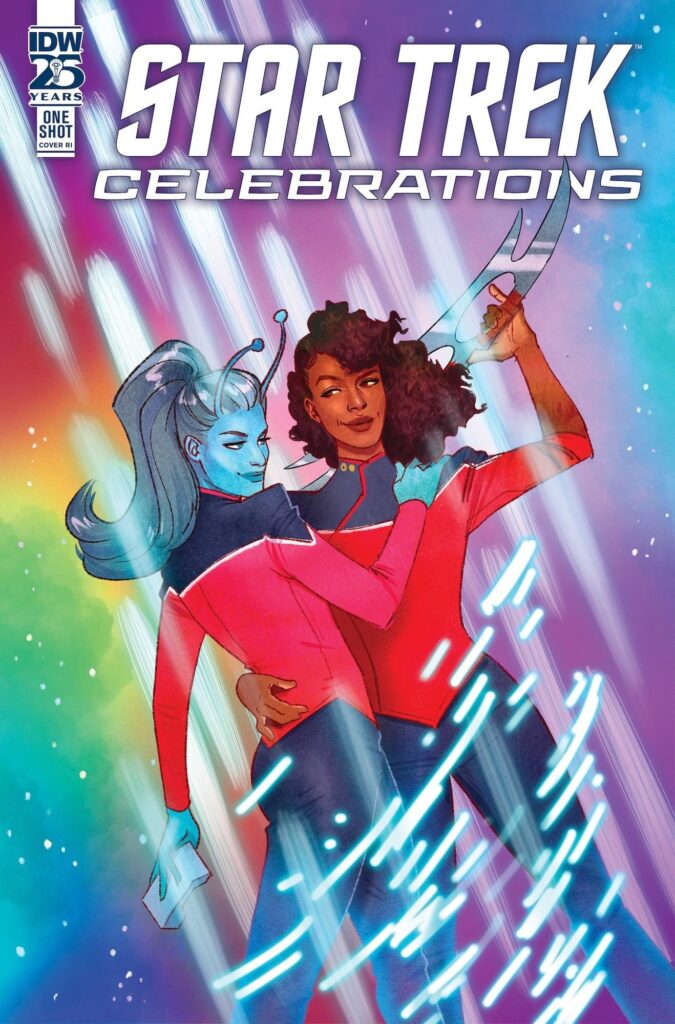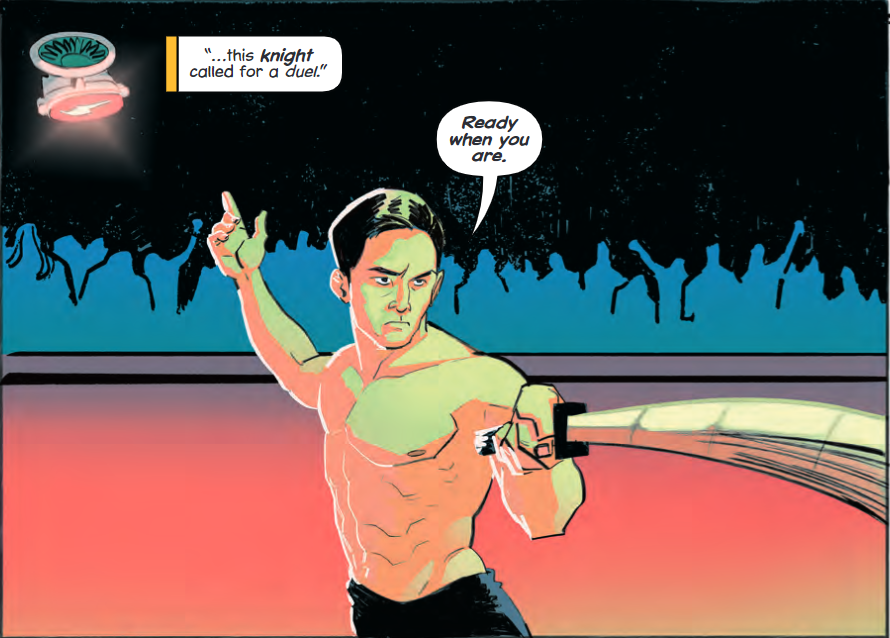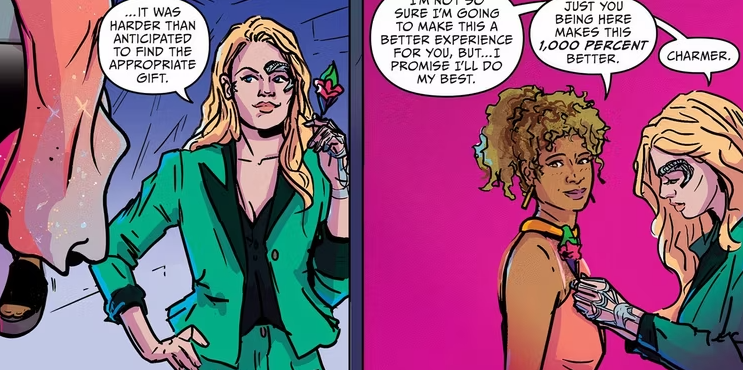
With Pride Month in full swing, you may have missed IDW’s gorgeous one-off anthology celebrating some of Star Trek’s most-loved characters. In Star Trek: Celebrations, IDW spotlights LGBTQIAP+ characters throughout the canon – Sulu, Raffi, Seven, Chapel, Stamets, Reno, and Mariner. (Interestingly, Culber, Adira, and Gray appear on the cover but not in the anthology. Culber and Stamets even have their own alternate cover but Stamets’s entry in the anthology is solely concerned with Reno. Fascinating.)
The anthology is comprised of five stand-alone vignettes drawn from the lives of, respectively, a father, a friend-zone couple, an established pairing with highly intellectual pursuits, two engineers solving starship issues, and a hopeful romantic. Spanning TOS, PIC, SNW, DIS, LD, with a lovely callback to ENT, it’s a joyful ode to the many ways Love triumphs over fear, frustration, self-doubt, grief, and drunk co-workers.
“The Knight Errand”

Steve Orlando’s “The Knight Errand” is an elegant fusion of classic and contemporary Trek, telling a Sulu-led TOS adventure framed as a child’s bedtime story. It plays on the swashbuckling skills established in TOS 104 “The Naked Time” and exhibited in the drill fight in the Star Trek (2009) motion picture. While Sulu is drawn to resemble John Cho, he credits the design of his sword to his ancestor, Hosato (George Takei’s given name).
The lingering effect of “The Knight Errand” is warm and familiar. Yes, the encountered alien culture is based on eternal selfish conflict. And Sulu does fight an exciting and appropriately violent duel with classic comic sound effects spelled out for us. (I particularly liked the “SLUKKKKT” stabbing noise.) But at the heart of it all, it’s a quest to return home to fulfill the expectations of a child.
There are shades of SNW 108 “The Elysian Kingdom,” where M’Benga’s devotion to his chronically ill child pushes him to the ethical edge of care to prolong her life. Even more so, Sulu’s repeated assertions that his bedtime appointment with his child is his priority recalls Sam Vimes’s unbreakable rule in Terry Pratchett’s Discworld that he must be home to read to his son at bedtime. For Sulu (and Vimes), their priorities are clear and their place is at their child’s side.
(Award for best visual Easter Egg given here for Demora’s stuffed Moopsy doll. At least, I hope it’s a stuffy.)
“Lady Luck”

From the warmth of family to the cringiness of class reunions. Vita Ayala’s title probably refers to The Tournament – a poker game at Raffi’s Starfleet Academy quinquennial reunion – but the game isn’t actually that important to the story, and Raffi doesn’t even stay for the last hand, so it’s an odd choice. The art style here conveys some of the chaos of the reunion in the pages of crowded, wordy panels. As the story resolves, the cleaner layouts provide visual relief that echoes Raffi and Seven’s more relaxed state.
What I found delightful is that the reunion takes place between the hand-holding at the end of Star Trek: Picard Season 1 and the events of Kirsten Beyer and Mike Johnson’s excellent audio drama Star Trek: Picard: No Man’s Land. It creates a narrative bridge that Raffi and Seven walk together and provides the opportunity for them to demonstrate/declare their affection for each other. For two people who carry as much personal baggage as they do, it’s always been a mystery how they were able to let down their guard with each other. And I’m game for anything that gives us more Raffi and Seven.
“Facemaker”
On the surface, this one is a treatise on Trek’s ethical grey areas in science and tech development. Exactly how far can the rules be bent before we’ve crossed over into forbidden territory? But the implications of “Facemaker” as a peek into Christine Chapel’s character development are intense and subtly heartbreaking.
A lot of the story’s weightiness relies on readers realizing when this story takes place. “Facemaker” occurs several years before Chapel joins the Enterprise and a year before the Klingon War where she and M’Benga serve together. This Chapel is all about the science and making technological breakthroughs while worrying about losing her place at the Stanford Morehouse Epigenetic Project.
Her research under Director Phlox (!) treads a delicate line between providing effective physical masking for away teams undercover in pre-warp societies and the potentially treasonous genetic interference the Federation’s “Section 7” polices. All this paves the way for the genetic tweaking tool she provides La’an, Spock, and Pike in Star Trek: Strange New Worlds’s series premiere when they embark to rescue Una from Kylie 279.
To be honest, she and Roz throw out a lot of techno-lingo as they brainstorm that I had to make an effort not to tune out. But their banter – specifically the respect and affection apparent in their interactions – sparked a few backstory theories about the multi-faceted Christine Chapel for me.
Taking a hard look at Chapel in “Facemaker,” we note that she’s in a long-term relationship, less than keen to join Starfleet, and seriously concerned about following the rules that deem her research taboo.
Compare this to what we know about Chapel from Star Trek: Strange New Worlds. In “Spock Amok,” Season 1 Episode 5, she’s determined to keep her relationships strictly casual and according to Ortegas, she’s been that way as long as they’ve known each other. She’s still a civilian on exchange to Starfleet from Stanford Morehouse but seems as at home on a Federation starship as in any research lab. (Later, of course, she will officially enlist with Starfleet under the command of Captain James T. Kirk for reasons.) Moreover, she repeatedly demonstrates that she is willing to be flexible in thought and action to fulfill the mission, treating directives as guidelines rather than absolutes in her endeavour to do what is right.
My theory credits Roz Lozana and their relationship for the changes in Chapel’s character. Losing Roz (however that happens) makes Chapel commitment-phobic. At the same time, she leans in on Starfleet. Whether that’s because, as Roz points out, Starfleet has the best research facilities, or it’s a way for Chapel to stay connected to her memory, is academic.
And then there are the epic truths Roz spills when encouraging Chapel to open her mind to all possible solutions. Springboarding off the tech that allows her to have the female form she wasn’t born with, Roz points out that answers will never be by the book when you exist on the leading edge of science: boundaries are there to be pushed.
“Starfleet is as much about defying orders as it is following them…. The fleet’s a walking, talking, uniformed uncertainty field.”
Roz’s blunt take on what means the ends can justify speaks to the heart of Trek heroism. No matter how far the science has progressed, scientists continue to seek more knowledge and deeper understanding without limits, and while we never get to meet her in SNW, Chapel clearly carries that spirit with her.

“Innovation Interruption”
I love me all the Jett Reno time I can get. And Reno butting heads with Stamets only to combine their geniuses to solve a potential catastrophe? Even better. The cherry on top of Stephanie Williams’s “Innovation Interruption” is we learn that old-school iPods survived World War III and can still function in 2257.
The artwork here reflects the practical nature of the core characters and uses a more portrait-realistic style than the other chapters. Even when they’re dealing with rogue nano-spiders, Reno and Stamets are outcome-oriented. It makes them an unstoppable team … when they can agree on the outcome they want.
Circling back to the aforementioned alternate Stamets and Culber cover, I wonder if this piece was added in place of a Stamets/Culber one to represent a non-family, non-romantic pairing. No complaints from me. Reno could read the Starfleet Technical Regulations Handbook and I’d tune in.
My only quibble is that programmable matter is a 32nd-century innovation. The anachronism of it being used by a Federation science team in prototypes before the Red Angel adventure is jarring to my suspension of disbelief.
The quiet peace Reno and Stamets enjoy at the conclusion of the adventure is a masterclass on how two respectful colleagues should end every job well done.
“Risian Rendezvous”
With Star Trek: Lower Decks being an animated series, its segue to graphic novel is visually seamless. This light-hearted romp on Risa falls near the beginning of Season 3, after Freeman’s been cleared but before “Mining the Mind’s Mines,” Season 3 Episode 3, where Mariner’s subconscious is full of thoughts of Jennifer wearing a bikini and demanding a long-term commitment.
It’s a classic comedy of situational errors with Mariner’s hopes of getting some quality time with Jennifer meeting obstacle after obstacle as most of the ship heads to the planet for the Festival of the Moon, a guaranteed Risian rager of a party. Interestingly, Shaxs and T’ana factor in more than one instance of mood-ruining. Awkward.
Even after breaking out some legendary Dirty Dancing moves, Fate (aka the mosh pit) literally carries Jennifer away from Mariner’s arms. Seeing Beckett at a loss and ready to give up is a new look for our most capable and confident Lower Decker. But even amidst the debauchery and hedonism of peak Risa crazy, there are quiet moments to be had where connections are made. Yay for Love!
Celebrations
Star Trek has always been aspirational. It’s the future we want to manifest now. It’s a hopeful mirror that includes everyone and reflects a universe of possibilities. Star Trek: Celebrations tells stories of people free to live, work, and play how they like with those they love. The bonus is each narrative enriches our understanding of familiar characters and fills in the corners of their world. Hopefully, there will be more anthologies like this to celebrate soon.
